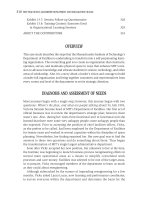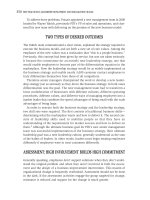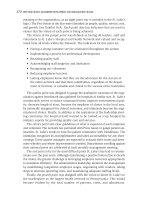Tài liệu Best Practives in Leadership Development & Organization Change 39 doc
Bạn đang xem bản rút gọn của tài liệu. Xem và tải ngay bản đầy đủ của tài liệu tại đây (132.96 KB, 10 trang )
350
BEST PRACTICES IN LEADERSHIP DEVELOPMENT AND ORGANIZATION CHANGE
To address these problems, Praxair appointed a new management team in 2000
headed by Wayne Yakich, previously PDI’s VP of sales and operations, and char-
tered his new team with delivering on the promise of the new business model.
TWO TYPES OF DESIRED OUTCOMES
The Yakich team communicated a clear vision, explained the strategy required to
execute the business model, and set forth a new set of core values. Among the
emphases of the new values was a realization that “this is a people business.”
Previously, this concept had been given lip service, but was not taken seriously.
It became the cornerstone for an entirely new leadership strategy, one that
would enable employees to become part of the differentiation equation in the
marketplace. Now the leadership strategy would be as widely implemented as
the business strategy and enable nearly 3,000 customer contact employees to
truly differentiate themselves from those of all competitors.
Therefore senior managers championed the work to develop a new leader-
ship strategy just as seriously as they drove the business strategy. In both cases
differentiation was the goal. The new management team had to transform a
loose confederation of businesses with different cultures, different operating
procedures, different values, and different ways of managing employees into a
market leader that combines the speed advantages of being small with the scale
advantages of being large.
In order to execute both the business strategy and the leadership strategy,
two skill sets were required. The first consists of traditional business skills—
determining what the marketplace wants and how to deliver it. The second con-
sists of leadership skills used to mobilize people so that they have an
understanding of the requirements for market success and how to deliver on
them.
2
Although the ultimate business goal for PDI’s new senior management
team was successful implementation of the business strategy, their ultimate
leadership goal was a new leadership culture, generally understood as the sum
of the habits of leaders. In other words, leaders must begin treating employees
differently if employees were to treat customers differently.
ASSESSMENT: HIGH INVOLVEMENT BUILDS HIGH COMMITMENT
Generally speaking, employees don’t support solutions when they don’t under-
stand the original problem and when they aren’t involved in both the assess-
ment and the design of a business improvement intervention. This maxim of
organizational change is frequently overlooked. Assessment should not be done
in the dark. If the assessment activities engage the group targeted for change,
resistance is reduced and support for the change is much greater.
cart_14399_ch15.qxd 10/19/04 1:17 PM Page 350
PRAXAIR
351
A second maxim of organizational change is that the assessment and design
phases should model the new values that underlie the change initiative—in this
case, a valuing of the contribution people can make to bottom-line business success.
With these principles in mind, Yakich chartered a three-person change team
to develop assessment tools for use with PDI’s top 175 managers, including all
senior managers, fifteen division general managers (DGMs) and all of their
direct reports. The change team, comprising the director of HR, the manager of
training and development, and an external consultant, recommended a four-
step leadership strategy design process
3
to engage these 175 managers in assess-
ing the current state of the leadership practices and the changes required if PDI
employees were to become a sustainable source of competitive advantage.
Listed below are the assessment tools, the steps followed in the assessment
process, and the assessment findings. The assessment process was deliberately
conducted to prepare the organization for future changes by engaging more than
five hundred employees—175 leaders in the top three levels of management and
over 325 employees—across all fifteen regional businesses.
Assessment Tools
The assessment tools were the following:
• An employee survey solicited feedback on the extent to which the busi-
ness strategy and leadership strategies were effective.
• A tool was used for comparing the current leadership strategy with the
one required to differentiate employees in the marketplace.
• An assessment tool called a Leadership Philosophy Map
4
was used to
define the core assumptions behind the portrait of a new manager.
• A leadership cultural assessment tool for use with senior managers and
division general managers (DGMs) clarified the change in leadership
culture required to support the newly emerging leadership strategy.
5
• Customer focus conferences
6
conducted in each of the fifteen divisions
brought representative customers together with customer contact
employees. The purpose of these conferences was to clarify the cus-
tomer contact behaviors, in terms of both attitudes and actions, that
would differentiate PDI employees from all other competitors.
Assessment Steps
The assessment was conducted in the following four steps:
1. All senior managers participated in a six-hour session to apply the
leadership strategy design tool to crystallize their own thinking about
needed changes.
cart_14399_ch15.qxd 10/19/04 1:17 PM Page 351
352
BEST PRACTICES IN LEADERSHIP DEVELOPMENT AND ORGANIZATION CHANGE
2. Division general managers conducted four-hour sessions with twelve
to fifteen managers from the next level of field managers, during which
the leadership strategy design tool identified gaps in the current and
desired leadership behaviors. This step also resulted in one Leadership
Philosophy Map from each session.
3. The 15 DGMs and senior PDI leaders then analyzed the input from
all the sessions to determine common themes and assess the gap
between the current leadership strategy and the one required to differen-
tiate employees. At this time, the group realized that they did not really
have a clear picture of the customer contact behaviors required to make
PDI employees distinctive. Rather than settling for a best guess, they
authorized a series of one-day, voluntary customer focus conferences so
that exemplary employees and customers, working together, could
develop the attitudes and actions that would set PDI apart from all other
suppliers. All fifteen divisions opted for the customer focus conferences
when they realized how energizing they were for employees and how
well received they were by participating customers.
4. Fifteen customer focus conferences were held, each engaging twenty to
twenty-five employees and two to three customer representatives who
shared their views on what customer contact behaviors would set PDI
employees apart from those of other suppliers. The output from these
conferences was a set of differentiating attitudes and actions identified
for each of the different customer contact groups (sales, drivers, inside
sales, counter sales, technicians, and so forth). These attitudes and
actions were consolidated into a master set for use companywide with
each group of customer contact employees.
7
Assessment Findings
The assessment phase lasted over fifteen months. But by the time it was com-
pleted, there was widespread agreement on the shortcomings of the current
leadership strategy and how to improve it. Resistance during the implementa-
tion phase was virtually nonexistent. Nearly every leader in the top three lev-
els of management understood why his or her current ways of managing
employees was deficient. And they all were willing to implement the action
plans that they themselves adopted, including prioritized management train-
ing, revised performance review procedures, and new performance-based com-
pensation schemes—all changes not normally supported by line managers.
Below is a summary of the major findings of the assessment phase.
The assessment phase was far more than a few surveys or focus groups. It
was an intensive set of actions, engaging more than five hundred employees
and simultaneously laying the foundation for implementation actions endorsed
by those whose behaviors were expected to change.
cart_14399_ch15.qxd 10/19/04 1:17 PM Page 352
PRAXAIR
353
1. Senior management
leadership strategy design
session
2. DGMs conducted four-
hour leadership strategy
design sessions
3. DGMs and senior team
consolidate input from all
leadership strategy design
sessions
4. Customer focus confer-
ences to determine differ-
entiating customer contact
behaviors
Exhibit 15.1. Assessment Steps
Assessment Step Assessment Findings
• The leadership culture is in drastic need of change.
DGMs and their direct reports must be engaged in
a process to determine the current leadership
strategy and how better to manage employees
• 175 managers are in surprising agreement that
the leadership strategy will not lead to differenti-
ating customer contact behaviors
• The industry orthodoxies on the management of
people were alive and well in PDI
• The new portrait of a successful PDI manager
must contain a different people-management
component
• The leadership values must be changed and
incorporated into key management practices
• Field managers were skeptical of senior man-
agers’ commitment to stay the course on the new
leadership strategy
• The new leadership philosophy map summarizes
the required portrait of all managers in PDI
• The new portrait makes it clear that current
supervisors have not been trained in requisite
management skills
• Nearly all of the 175 managers have a strong
desire to improve their managerial skills
• The differentiating attitudes and actions are too
general at this stage to be useful. Therefore,
employees and customers must be engaged to
add greater specificity
• Customers confirm the critical role of customer
contact employees in differentiating PDI from
other suppliers
• Employees are surprised that their opinions count
and are being taken seriously
• Employees leave feeling highly engaged and will-
ing to change their own behaviors. The message
that employee opinion matters ripples throughout
the company
• Employees feel frustrated that some managers tol-
erate weak to mediocre customer contact behaviors
• Specific attitudes and actions are developed for
the different groups of employees who contact
customers
• Barriers to improved customer focus are identi-
fied and local action plans adopted
cart_14399_ch15.qxd 10/19/04 1:17 PM Page 353
354
BEST PRACTICES IN LEADERSHIP DEVELOPMENT AND ORGANIZATION CHANGE
DESIGN: AN ITERATIVE PROCESS
Organizational change of the magnitude undertaken by PDI is often likened to
changing the tires on a car that is traveling at 70 miles per hour. The metaphor
is quite apt. No change plan, no matter how well designed, can possibly antic-
ipate all the bumps and curves in the road. Consequently, PDI followed an iter-
ative design process. Each step of the change was designed, implemented, and
then evaluated. The next step was designed based on the outcomes of the pre-
vious one. Along the way, business performance, budget constrictions, and mar-
ket dynamics, to name just a few of the “bumps” in the road, had to be
considered in designing the next steps. For instance, no one anticipated need-
ing customer focus conferences to help clarify customer contact behaviors. They
were designed as a result of an unforeseen outcome from the previous step—
that line managers did not know how employees could distinguish themselves
in the eyes of customers. That being said, the PDI change team followed two
fundamental principles, a focus on new or revised management practices and
visible senior management support.
Management Practices Are Central to the Change
in Leadership Culture
The first three steps of PDI’s leadership strategy design process were actually
assessment steps. The true design work took place when the management prac-
tices were aligned with the new leadership values. Values mean nothing if they
aren’t reflected in how managers actually behave. Therefore, the PDI change team
asked senior managers and field managers to prioritize the management practices
to be changed first. The intent was to identify the management practices that
would have the most impact early in the change process. The priority manage-
ment practices were (1) skills training for managers and (2) realignment of the
profit-sharing plan to incorporate division performance as part of the formula.
Other management practices to be redesigned included:
• Employee survey—to include questions about the new leadership strat-
egy and the consistent practice of the new customer contact behaviors.
• Customer scorecards—to provide feedback from customers on the atti-
tudes and actions for each group of employees who routinely talk to
customers. The feedback is managed by employee groups who take
ownership for the results and formulate ways to improve their own cus-
tomer contact behaviors. Managers are consulted when policy questions
are involved or when actions may have an impact on other functional
areas.
• PDI playbook—a desktop reference guide for all employees containing
pertinent company information, including PDI’s vision, values, goals,
cart_14399_ch15.qxd 10/19/04 1:17 PM Page 354









